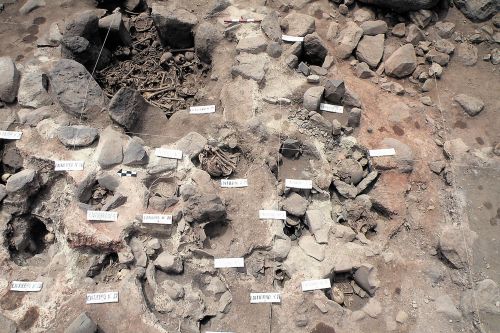LIMA, Nov 20, 2011 (AFP) - A Peruvian archeologist on Sunday announced the discovery of the remains of 44 infants and young children sacrificed to appease ancient deities in the 14th century at a site in the high Andes near the border with Bolivia.
The remains were found near a stone funeral tower -- known locally as chullpas -- in the Sillustani archeological site, located some 1,300 kilometers (800 miles) south-east of the capital Lima, near Lake Titicaca, which Peru shares with Bolivia.
"These are children and babies of both sexes, with ages going from newborns to the age of three," archeologist Eduardo Arisaca told local regional media.
His remarks were picked up by the daily El Comercio.

The infants were buried in pairs inside funeral baskets or in ceramic urns near a 10 meter (32 feet) tall circular stone brick tower known as Chullpa Lagarto (Lizard Chullpa).
The children were buried with a volcanic stone on their chest, and are surrounded by offerings -- animals, food, dishes and pitchers. Early research suggests they were sacrificed during a period of warfare.
"The faces of the children point towards the east," where the sun rises, said Arisaca. He estimated the children were buried between 600 and 700 years years ago.
The children also had artificially elongated skulls, common among some nobles of the time.
Up to now the remains of 200 people have been unearthed around the Chullpa Lagarto, Arisaca said.
In September Arisaca announced the discovery of the 700 years-old remains of a two year-old boy at a separate funeral tower in Sillustani, buried in a ceramic urn along with a dog.
At another funeral tower nearby experts found the remains of 12 adults buried together along with food, ceramics and animals. Archeologists found sheets of gold attached to the clothing as part of the attire.
The funeral towers, are common sights in the high Andean region between Peru and Bolivia, are the burial sites of ancient nobles and community leaders.
Most are round towers built of stone, but some are rectangular.
<한글기사>
외계인? 페루서 대규모 유아 미라유해 발굴
남미 페루에서 '잉카문명'을 전후해 희생된 것으로 보이는 유아들의 유해와 미라가 잇따라 발견돼 관심을 모으고 있다.
21일(현지시간) 영국 BBC방송 인터넷판 등에 따르면 미라가 줄곧 발굴돼 온 페루 남동부 시유스타니 지역의 고고학자들은 최근 600∼700년 전에 희생된 것으로 추 정되는 영아 유해 44구를 발견했다.
학자들은 이들의 나이가 신생아에서부터 3살 정도로, 1200년∼1450년 페루 남부 '푸노' 지방을 통치했던 '코야' 문명 시대에 살았던 것으로 보인다고 밝혔다.
유골은 묘비 주변에 있던 여러 개의 상자 안에서 나왔으며 각각의 유골 가슴 위에는 화산석과 함께 접시나 주전자 등 다양한 제물들도 주위에서 발견됐다.
학자들은 유골과 함께 전쟁 그림이 담긴 도자기가 출토된 점을 근거로 유아들이 코야와 경쟁 문명 간 전투 시기에 희생된 것으로 추정하고 있다.
시유스타니 지역은 페루 수도 리마에서 남동쪽으로 1천300㎞ 가량 떨어진 고고학 유적지로 지금까지 200여구의 유해가 발견된 바 있다.
이와 함께 잉카문명의 발상지인 쿠스코에서는 독특한 모습의 미라가 발굴됐다.
현재 페루 한 박물관에 전시 중인 이 미라는 키가 50㎝정도 불과하지만 머리 크기가 몸에 비해 비정상적으로 큰 데다 모양도 삼각형에 가까운 모습을 하고 있다.
또 안구가 있었을 눈구멍도 보통 미라와 달리 매우 크고, 턱에는 물고기 지느러 미같은 것이 달려 있는 것으로 전해졌다.
현지 언론들은 특이한 생김새를 근거로 외계인의 미라가 아니냐는 주장을 내놓고 있지만 인류학자들은 머리가 매우 큰 2세 이하의 유아의 것으로 추정하고 있다.
학자들은 잉카문명이 존재했던 산악지역에서 어린 아이를 제물로 바쳤던 사료를 근거로 이 미라가 집단 의식에 희생된 것으로 보고 있다.


![[Exclusive] Korean military set to ban iPhones over 'security' concerns](http://res.heraldm.com/phpwas/restmb_idxmake.php?idx=644&simg=/content/image/2024/04/23/20240423050599_0.jpg&u=20240423183955)




![[Pressure points] Leggings in public: Fashion statement or social faux pas?](http://res.heraldm.com/phpwas/restmb_idxmake.php?idx=644&simg=/content/image/2024/04/23/20240423050669_0.jpg&u=)



![[Herald Interview] 'Amid aging population, Korea to invite more young professionals from overseas'](http://res.heraldm.com/phpwas/restmb_idxmake.php?idx=644&simg=/content/image/2024/04/24/20240424050844_0.jpg&u=20240424200058)






